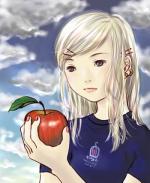Cause for Concern In Chinese Bulbs?
我们需要担心中国蒜头吗?
华盛顿邮报6月20日电
Most of us buy garlic at a supermarket. We don't know what kind it is, how fresh it is or where it's grown. But there's a good chance it comes from China, which produces 75 percent of the world's supply.
大多数人是在超市买大蒜的,不知道它是什么品种、是否新鲜.也不知道它产自何处。但它很有可能来自中国,全世界75%的大蒜由这个国家供应。
Garlic is the United States' biggest fresh-vegetable import from China, which sent us 138 million pounds of it worth more than $70 million last year. We also get small amounts from Mexico, Argentina and about 15 other countries. We eat a lot of garlic -- about three pounds per person a year.
大蒜是美国从中国进门最多的新鲜蔬菜,去年共1.38亿磅。我们还从墨西哥、阿根廷和另外约15个国家少量进口。我们爱吃大蒜,平均每人每年消耗三磅。
Although most of our fresh garlic comes from halfway around the world, it's cheaper than garlic grown in California. For example, California garlic bulbs were priced at $4.99 a pound at Whole Foods Market last week, but a pack of five Chinese bulbs -- about a pound -- were just 79 cents at Great Wall supermarket in Falls Church. The U.S. Department of Agriculture says garlic prices have dipped 12 percent in a decade.
虽然我们的大多数新鲜大蒜来自相距半个地球以外的国度,但还是比在加利福尼业种出来的大蒜便宜。例如上周食品市场,加利福尼亚蒜头每磅卖4.99美元,而五头中国蒜(约一磅)只卖79美分。美国农业部透露,十年来大蒜的价格下降了12%。
California growers think that stinks, because it's killing their business. They grew 18,000 acres of garlic last year, which is only about 2 percent of the world's supply. A decade ago, they grew 36,000 acres. In the early 1990s, U.S. trade officials found that China was "dumping" garlic, or selling it below what it cost to produce. A 377 percent tariff caused imports to dip for a while until shippers found a loophole.
加利福尼亚种植者感到恼火,因为这砸了他们的生意。他们去年种了1.8万英亩大蒜,只占全世界供应量的大约2%。10年前他们种3.6万英亩。20世纪90年代初,美国贸易官员发现中国“倾销”大蒜,也就是以低于生产成本的价格出售。377%的关税使进口额一度下降.但出口商很快找到空子可钻。
Some California growers and processors say that even though they don't like Chinese garlic, they buy some because it's cheaper than what it costs them to grow it -- even in Gilroy, the "Garlic Capital of the World"。
一些加利福尼亚农场和加工商表示,尽管他们不喜欢中国大蒜,但也买一些,因为这比自己种要便宜.就连“世界大蒜之都”Gilroy也不例外。
Bill Christopher of the 50-year-old Christopher Ranch there, one of the largest U.S. growers, explained why: "A 30-pound box of Chinese garlic is $14, but our cost [to produce it] here is $26.27." Although he claims California garlic tastes better -- independent lab tests show it's denser in texture than Chinese -- his company uses imports in some prepared products, such as sauces.
有着50年历史的Christopher农场是美国最大的大蒜农场之一,主人Bill Christopher说“一箱30磅重的中国大蒜卖14美元,而我们在本地种出这么多大蒜的成本是26.27美元。”虽然他声称加利福尼亚大蒜的味道更好(他们的独立实验室测试结果表明,他们的大蒜质地比中国的更密),但他的公司在生产蒜汁等制成品时仍使用进口大蒜。
The U.S. Department of Agriculture's Foreign Agricultural Service says dehydrated Chinese garlic imports increased 384 percent in the past 10 years. Layous and others cite a 2002 report by the now-defunct Americans for Wholesome Food, a coalition of businesses and organizations dedicated to educating consumers, on domestic and imported garlic powder. The AWF's report, based on independent lab tests, found "high levels of lead, arsenic and added sulfites in two supermarket-brand imported garlic powders from store shelves."
美国农业部农产品外销局称,过去十年间,脱水中国大蒜的进口量增加了384%。现已解散的“美国人捍卫健康食品”组织致力于自消费者传授相关知识,它在2002年发表报告,以独立的实验室检测结果为依据指出:“商店货架上的两大超市品牌进口蒜粉含大量铅、砷和亚硫酸盐。”
So how safe is garlic?
"Unless there's an import alert out from the FDA," says agency spokeswoman Kimberly Rawlings, food "is considered safe."
中国大蒜究竟是否安全?美国食品和药物管理局(FDA)发言人Kimberly Rawlings说:“只要FDA没有发布进口警告,就可以认为是安全的。”
The FDA said it could not provide information on detention and refusal rates of Chinese produce and how they compare with those for other countries. But FDA records show that since 1994, fresh and processed garlic have been targeted for automatic detention and surveillance. Numerous shipments from several companies -- five Chinese, one Canadian and one Argentine -- were refused because of insects or insect damage, mold or filth between 1994 and 1996. The Canadian firm had repacked Chinese garlic and shipped it, peeled, in five-pound jars. Thirteen fresh garlic shipments from China were refused at California ports.
美国食品和药物管理局表示,它拿不出中国产品被扣下或被拒收的比例,也无法跟其它国家对比。但该机构的记录显示,自1994年以来,新鲜大蒜和加工过的大蒜都是必须被扣下接受监督的。1994年至1996年间,来自若干国家的好几批大蒜(中国五批,加拿大一批,阿根廷一批)因为有虫子或虫咬痕迹,发霉或肮脏而被拒收。加拿大那家公司是把中国大蒜剥皮后重新包装出口的。加利福尼亚各个港口总共拒收了13批来自中国的新鲜大蒜。
A Washington Post search of nearly 900 FDA "refusal actions" from May 2006 to April 2007 turned up 18 shipments of garlic products from several countries. Some examples of rejections: from China, chili garlic sauce, because manufacturing information was not provided; from Canada, garlic paste, made in unsanitary conditions and inadequately labeled; from Argentina, "filthy" garlic bulbs.
记者浏览了美国食品和药物管理局从2006年5月到2007年4月的约900次“拒收行动”,发现其中包括18批来自若干国家的大蒜产品,例如来自中国的辣蒜汁,原因是未标明厂家信息;来自加拿大的蒜泥,生产环境不卫生且标注不全;来自阿根廷的“脏”蒜头。
For several reasons, experts say, fresh garlic is safer than processed, and they suggest ways for consumers to make it even safer.
有专家称,由于若干原因新鲜大蒜比加工过的大蒜要安全。他们给消费者提出了几条增强安全生的建议。
Michael Doyle, director of the Center for Food Safety at the University of Georgia, says that garlic has natural inhibitors against pesticides. Marion Nestle, professor of nutrition and food studies at New York University and author of "What to Eat," says the skin also protects somewhat against pesticides, if any were used. "Pesticide residues can be removed by washing," she says.
Georgia大学食品安全中心主任Michael Doyle说大蒜含有天然的农药抑制剂。纽约大学的营养学教授、《What to Eat》一书的作者Marion Nestle说,大蒜皮也多多少少可以阻挡农药,“用水洗可以去掉残留农药。”
E. coli and other bacteria on fresh garlic would probably be only on the exterior, Nestle says.
Nestle说,新鲜大蒜上的大肠杆菌等细菌大概只停留在表面。
She and Doyle agree that besides peeling and discarding the skin, the one sure-fire way to kill off microorganisms is to turn up the heat.
"A quick dip in boiling water would do it," Nestle says, "as would searing."
她和Doyle都认为,除了剥去表皮之外,杀死微生物的万全之策是高温灭菌。Nestle说“在开水里浸一下就行,煎一煎也可以。”
 wz9th
发布于2007-06-22 17:46:39
wz9th
发布于2007-06-22 17:46:39
 xljtina
发布于2007-06-30 02:31:07
xljtina
发布于2007-06-30 02:31:07
 xbsff发布于2007-07-02 09:29:58
xbsff发布于2007-07-02 09:29:58
 燕丫头1205发布于2007-07-02 10:23:17
燕丫头1205发布于2007-07-02 10:23:17
 snowtiger
发布于2007-07-17 10:26:43
snowtiger
发布于2007-07-17 10:26:43
